|
>> Catalog of Tomorrow Rough Drafts: Deep Sea | SETI | Deep Space
|
Reduce, re-use, recycle. Oddly enough, this mantra of environmental sustainability also sums up the requirements for economically viable spaceflight: reduce weight, re-use the rockets, vehicles, and tools, and recycle the components. Innovations in materials science coupled with the march of Moore's Law faster, smaller, cheaper, more interconnected microprocessors will unlock the doors of space for scientists, businesspeople, tourists, even students and their teachers. Especially if the technological innovations can be combined with design enabling "continuous intact abort capability" that is, the ability to abort a flight safely at any point during the flight, and return home. Then a safe path to space will truly be accessible to all. Our first tours of Mars will be on-line. A sash of satellites in orbit above Mars will relay commands to sensor stations and robots on the Red Planet, and transmit data and visuals back to Earth. The first node of a system-wide "Interplanetary Internet," this communications network will allow scientistis to explore via telepresence and teleoperation and allow the rest of us to kibbitz. Based on the communications protocols of our terrestrial Internet, the architecture will more closely resemble a "network of Internets," in order to handle the varying transmission times between moving planets. Initially, designers will focus on security to prevent the "hacking" of Mars. But in two decades, a popular coffeebreak pastime may well be pitting one's reflexes against interplanetary lag times to control small roving robots on Mars or the Moon. By 2015, an entire silicon ecology of robots could act as on-line tour guides on Olympus Mons, or through Valles Marineris. The prototypes are already there: Pathfinder and its mobile unit, Sojourner, as well as the Mars Global Surveyor. But NASA has even more robots in the works, ready for launch over the next decade. In 2003 NASA will launch twins: the identical Athena geological rovers, building on the success of Sojourner. Space scientists are also borrowing from nature to design autonomous, insect-like robots that could be deployed in large numbers, and nanoscale information sensors that could be dusted across the landscape. |
|||
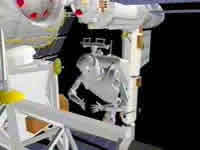   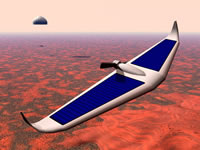
|
|||
|
Rovers, however, can only rove so far. The subsequent generation of Mars explorers could be airborne, and inflatable. NASA and students at MIT are designing robotic airplanes and gliders to skim through the valleys and canyons of Mars, and ride thermals over its mountains. Hot air balloons, which would rise in the relative warmth of day to land again at night, are also on the drawing boards. All these designs rely on inflatable structures. The Jet Propulsion Laboratory's "Gossamer Spacecraft Initiative" explores these uses as well as designs for lightweight, inflatable telescopes, "ballutes" (balloon parachutes) and light, inflatable heat shields. NASA cancelled the X-33 spaceplane prototyping but continues its search for transportation systems to carry people and equipment safely and reliably to orbit as are over twenty private engineering teams. (see sidebar) While spaceplanes like the Pan Am spaceplane seen in "2001" represent one design path, we may one day simply take an elevator to orbit. Tsiolkovsky and colleagues in Russia suggested "space towers" to lift passengers and cargos out of Earth's gravity well, and Arthur C. Clarke portrayed the idea in his novel, The Fountains of Paradise. New high-tensile strength, self-healing composites and materials will not only make our spaceplanes safer, but could make the idea of a floating tether a cable dangling down, and stretching out, from a "buoy" in orbit feasible. The lower docking station would be suborbital, allowing simpler, lower-cost spaceplanes to ferry people to the "elevator's" lowest point. Passengers would then ride for several hours in large, comfortable gondolas up the cable to a space station at mid-point. Interplanetary cargo would continue up the cable to the high end, where it would be flung off the cable at speeds exceeding escape velocity. |
|||
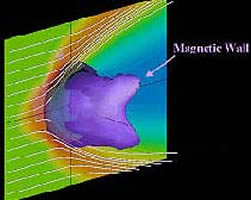 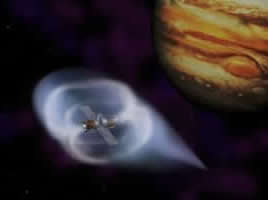 |
|||
|
With weight one of the biggest constraints in launch costs, designers are also using advanced materials such as highly heat-resistant, featherweight carbon mesh to make inflatable interplanetary and interstellar spacecraft, such as solar sailers. Solar sailers will rely on the faint push of the solar wind on carbon mesh sails miles wide to accelerate lightweight, unmanned craft to speeds as high as ten percent of lightspeed. Scientists are also working on solar sailors whose "sails" will simply be bubbles of magnetic force. On the far edge of interstellar spacecraft design are even more "breakthrough propulsion projects" -- theoretically intriguing, but requiring revolutionary insights into physics and the fabric of space-time. These include ideas to utilize "zero point energy" essentially, the background buzz of the universe to explore possible applications of black hole physics, to understand the relationship between the electromagnetic spectrum and gravity, and to theorize about warping the spacetime continuum. Armstrong's boot hit moondust on 20 July 1969. Thirty-three years later, we have not yet visited any other planets. This is not a lack of technology, but a lack of public and political will. Space exploration is expensive, and, given real and serious problems here on Earth, less politically aerodynamic than it was during the Cold War. Early NASA culture had internalized the von Braun strategy for interplanetary exploration: this assumed a monumental staged effort, stairstepping from large infrastructure to large infrastructure build rockets, then build a space station, next a Moonbase, and finally launch to Mars. Obviously, the magnitude of this approach renders it astronomically expensive. The manned Mars proposal Bush rejected so resoundingly in 1989 featured $450 billion worth of expenses. The "smaller, faster, cheaper" use of robotic exploration devices during the 1990s reflected the resulting innovation of economic necessity.
|
|||
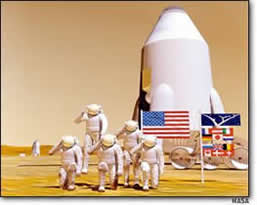 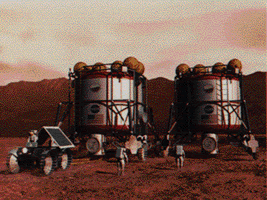 |
|||
|
An alternate strategy for manned missions to Mars, called the "Mars Direct" approach, was championed by Robert Zubrin in his 1996 book, The Case for Mars. Taking lessons from history successful explorers lived off the land it proposes unmanned flights to Mars in advance of manned flights: first send robots to Mars to process fuel from the immediate environment, to build habitats, and to land return vehicles. Then send people. Could we mount a manned expedition by 2015? NASA estimates it will cost $50 billion, and does not wish even to consider it until 2020. Yet on 5 July 2002, the Russians suggested a $20 billion collaborative effort between NASA, ESA, and themselves aimed at launching a manned mission by 2015. We are curious; we are adventurers, tool-creators, games players, problem-solvers, and visionaries. When isolated and deprived of stimulus, we languish; when in good company and free to explore, we thrive. The first person to set foot on Mars has already been born: the rest of us must simply commit to sending her.
|
|||
|
"Komerex tel khesterex."
An old Klingon proverb: grow, or die. |
|||
|
|||
> Essays > Change > Octopus | Tomorrow | Arts | Governance | America's Futures | Borders
>> Catalog of Tomorrow Rough Drafts: Deep Sea | SETI | Deep Space
| 15
February 2003. Email
IF. Copyright © 2003, Wendy L. Schultz All rights reserved. |
people have explored our infinite futures. (in addition to the 17,500+ visitors from 10/1/2001-12/15/2002). |














